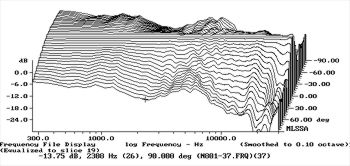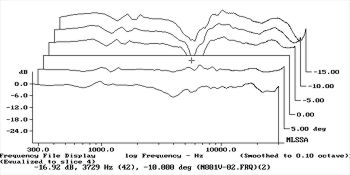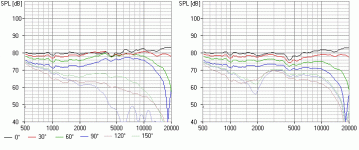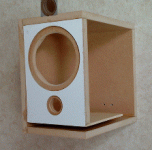B&W use separate tweeter enclosures to address the issue of reflections off the baffle. Why do most other high end companies leave the baffle perfectly untreated and even in some cases with sharp edges?
There must be a good reason for not addressing this issue. Cost and aesthetics doesnt count as a good reason because the whole idea of high end audio is to achieve great sound at any cost. A small minority use felt. At least that's an attempt.There is no question that any design involving drivers on a flat baffle suffers from this problem.
There must be a good reason for not addressing this issue. Cost and aesthetics doesnt count as a good reason because the whole idea of high end audio is to achieve great sound at any cost. A small minority use felt. At least that's an attempt.There is no question that any design involving drivers on a flat baffle suffers from this problem.
Good question, but wrong understanding of the initial reason to use separate tweeter enclosures:B&W use separate tweeter enclosures to address the issue of reflections off the baffle. Why do most other high end companies leave the baffle perfectly untreated and even in some cases with sharp edges?
There is no such thing as baffle reflection from the tweeter. A reflection off the baffle would need a wave with an incident angle greater zero. Where should that come from 😕
The purpose for separate (and small) tweeter enclosures is to avoid baffle edge diffraction and uneven polar response generated by any large baffle and/or sharp baffle edges.
But don't ask me, why manufacturers don't care about it 🙄
Rudolf
There is no such thing as baffle reflection from the tweeter. A reflection off the baffle would need a wave with an incident angle greater zero. Where should that come from
Rudolf
can you explain this? Im imagining the sound from the tweeter spreading out and hitting the baffle then being reflected. Maybe I'm using the word reflection in an non technical way.
Modern B&W jobs with those Ti job tweeters are not all that special. Honestly, I think a pair of 600 series from back in the 90s when they didn't have that "fancy" tweeter operation sounded far better. At the end of the day, speaker placement in the room you are listening in, will have more of a useful effect on things than the effect of the baffle anyways.
IMO: worry less about the speaker design related issues, and more about speaker placement and amplification quality.
IMO: worry less about the speaker design related issues, and more about speaker placement and amplification quality.
I'd say that B&W is a bad example as the seperate "pods" create more acoustical problems than they could ever solve. I believe that some customers look at them and think there must be some issolation or perhaps an acousticaal benefit so they have created a perception of doing something. In truth they give an unbaffled tweeter an opportunity for reflections off of the cabinet below. No thank you.
As to "why not felt", some companies do add them. As a manufacturer, your first question has to be whether grilles will be included or not. If so, then the grille on and grille off issue would hae to be addressed. It is hard to get a treatment that works well for both cases (although we did a pretty good job at Snell on a few models).
Hard edges on a square box give effects that can always be measured, but if you scatter the driver to edge distances they start to minimize. If you assume the listener will be off of the exact axis of the driver, this will likely minimize the effect further. For this reason I think many manufacturers are willing to ignore them. foam o felt on a baffle isn't the best looking thing and I think that further drives companies away from attempting it.
On another site (Classic Speakers), when I bring up the AR acoustic blanket, I always get a number of experts who proclaim that only power response matters and that small aberations in the direct field can't be heard. I am convinced they are wrong but at the same time the effect can be minor if you are careful with mounting (even on a sharp edged untreated cabinet).
Other companies such as Genelec do a very good job of adding a directional flare that give a good blend to the cabinet with a little bit of directivity to make the edges harder to see.
David S.
As to "why not felt", some companies do add them. As a manufacturer, your first question has to be whether grilles will be included or not. If so, then the grille on and grille off issue would hae to be addressed. It is hard to get a treatment that works well for both cases (although we did a pretty good job at Snell on a few models).
Hard edges on a square box give effects that can always be measured, but if you scatter the driver to edge distances they start to minimize. If you assume the listener will be off of the exact axis of the driver, this will likely minimize the effect further. For this reason I think many manufacturers are willing to ignore them. foam o felt on a baffle isn't the best looking thing and I think that further drives companies away from attempting it.
On another site (Classic Speakers), when I bring up the AR acoustic blanket, I always get a number of experts who proclaim that only power response matters and that small aberations in the direct field can't be heard. I am convinced they are wrong but at the same time the effect can be minor if you are careful with mounting (even on a sharp edged untreated cabinet).
Other companies such as Genelec do a very good job of adding a directional flare that give a good blend to the cabinet with a little bit of directivity to make the edges harder to see.
David S.
It's got to be a little of both, eh? I listen mostly in the far (diffuse) field, and for amplitude response "diffraction effects" hardly seem to matter. Localization and "imaging" is still determined by the direct sound, though, and maybe diffraction sends confusing position clues. In the near field, though, diffraction peaks (and nulls) are more audible. And more position dependent . . .I always get a number of experts who proclaim that only power response matters and that small aberations in the direct field can't be heard.
Sound is travelling radially in all directions from the tweeter. But it does not travel in curves. If you imagine concentric rings/spheres around the tweeter center, sound has to travel perpendicular to them, NOT along them.can you explain this? Im imagining the sound from the tweeter spreading out and hitting the baffle then being reflected.
In truth they give an unbaffled tweeter an opportunity for reflections off of the cabinet below. No thank you.
David S.
So why are you telling me reflections off the cabinet below can occur yet Rudolph says it cant occur on a baffle?
Because the tweeter effectively has no baffle so it can occur.
With a typical speaker, the tweeter is mounted on a baffle wide enough to accept the midrange driver, if not the woofer as well. In this case, the sound from the tweeter expands as a hemisphere since the baffle constrains the pressure waves to the plane of the baffle. Once the wave reaches the edge of the baffle, it starts to expand as a full sphere, and now we are pressurizing air behind the plane of the baffle.
With the tiny B&W tweeter pod, the sound expands as a sphere almost immediately, and thus there will be reflections when the wave hits the top of the main cabinet. You'll note the top of the B&W 800's main cabinet is curved, so these reflections are diffused and any interference they cause reduced.
With a typical speaker, the tweeter is mounted on a baffle wide enough to accept the midrange driver, if not the woofer as well. In this case, the sound from the tweeter expands as a hemisphere since the baffle constrains the pressure waves to the plane of the baffle. Once the wave reaches the edge of the baffle, it starts to expand as a full sphere, and now we are pressurizing air behind the plane of the baffle.
With the tiny B&W tweeter pod, the sound expands as a sphere almost immediately, and thus there will be reflections when the wave hits the top of the main cabinet. You'll note the top of the B&W 800's main cabinet is curved, so these reflections are diffused and any interference they cause reduced.
It's got to be a little of both, eh? I listen mostly in the far (diffuse) field, and for amplitude response "diffraction effects" hardly seem to matter. Localization and "imaging" is still determined by the direct sound, though, and maybe diffraction sends confusing position clues. In the near field, though, diffraction peaks (and nulls) are more audible. And more position dependent . . .
The ear is pretty good at hearing through to the direct sound even when measurements show the reverberent field is dominant.
Here is the easy test. Have a friend hold a small ruler edgewise on the baffle. They will have to stand behind and reach over the cabinet. This represents a worst case grille reflection.
Put pink noise on and then slide the ruler back and forth across the baffle surface a few inches away from the tweeter. (Have the ruler on the far side of the tweeter relative to your listenng position.) You will hear a comb filter effect that rises and lowers in frequency depending on distance of ruler to tweeter.
You can hear it from nearby the the system to well beyond the critical distance.
David S.
So why are you telling me reflections off the cabinet below can occur yet Rudolph says it cant occur on a baffle?
Professor,
I was under the impression that you were referring to the baffle, where the tweeter is mounted on:
The tweeter would radiate like the green arrow. There is no radiation like the red arrow. But if the green arrow would hit a protruding baffle below the tweeter baffle, then there will be a reflection. I believe this is what speaker dave is talking about.
Just to take this a bit further, look at this little speaker with two different tweeter positions. One on the baffle and one as the pure little tweeter (Dayton ND20-FA6) on top of the baffle:
Compare the (simulated horizontal) radiation patterns:
Left is the situation ON the baffle, right is ABOVE the baffle. Notice how the 90° radiation (blue line) for the baffle-less tweeter is significantly lower than 90° for the tweeter on the baffle. I still believe B&W are knowing their business. 😉
Rudolf
Attachments
is that your box rudolph? what do you think a point source would sound like if it were possible, and if there was no distortion whatsoever?
My understanding of the graphs you posted is that for the tweeter above the baffle, the radiation is more even and doest fall so rapidly with respect to angle. Why is that?
Regarding your picture with the tweeter and red and green arrows, without the baffle you say the tweeter would radiate spherical waves. But with a baffle the waves cannot go behind the plane, so why arent they reflected? imagine the green arrow you drew was pointing at 45 degrees behind the baffle. isnt this what would happen without the baffle?
My understanding of the graphs you posted is that for the tweeter above the baffle, the radiation is more even and doest fall so rapidly with respect to angle. Why is that?
Regarding your picture with the tweeter and red and green arrows, without the baffle you say the tweeter would radiate spherical waves. But with a baffle the waves cannot go behind the plane, so why arent they reflected? imagine the green arrow you drew was pointing at 45 degrees behind the baffle. isnt this what would happen without the baffle?
At relatively low frequencies (5 to 10 kHz for the 1" tweeter) the waves radiate hemispherically and so some percentage of image follows the surface much like the green arrow.
Eventually it hits either a reflective surface or an edge. If it hits an edge it will diffract around the corner towards the back side. In conjunction with that diffraction will be a negative pressure re-radiation in all directions from the edge. This is typical of any wave phenomonon. If a wave hits a short circuit it reflects in phase. If it hits an open circuit it reflects out of phase. Hitting the edge of the box and falling off into the void behind is a reduction in the impedance the wave is traveling along. For either case the reflection must add and subtract based on the timing relative to the initial wave. This must give at least mild comb filtering to the combined response.
A large radius can reduce the reflected energy from an edge. Having a corner that bevels back at 45 degrees can also be an improvement over a sharp 90 degree corner. Staggering the edge distances can scatter the reflection timing of the several edges surrounding a tweeter. Adding a foam barrier can absorb some of the energy on the surface and thereby help. I have even tried having a reflective dam balance out a diffractive edge at the same distance (remember, positive and negative reflections).
Computer programs such as The Edge are getting good at modeling diffraction/reflections. It is also easy to mess with experimentally. When I get a chance I will put some styrofoam corners on a cabinet and try a progression of radii to see how much corner softening is required.
David
Eventually it hits either a reflective surface or an edge. If it hits an edge it will diffract around the corner towards the back side. In conjunction with that diffraction will be a negative pressure re-radiation in all directions from the edge. This is typical of any wave phenomonon. If a wave hits a short circuit it reflects in phase. If it hits an open circuit it reflects out of phase. Hitting the edge of the box and falling off into the void behind is a reduction in the impedance the wave is traveling along. For either case the reflection must add and subtract based on the timing relative to the initial wave. This must give at least mild comb filtering to the combined response.
A large radius can reduce the reflected energy from an edge. Having a corner that bevels back at 45 degrees can also be an improvement over a sharp 90 degree corner. Staggering the edge distances can scatter the reflection timing of the several edges surrounding a tweeter. Adding a foam barrier can absorb some of the energy on the surface and thereby help. I have even tried having a reflective dam balance out a diffractive edge at the same distance (remember, positive and negative reflections).
Computer programs such as The Edge are getting good at modeling diffraction/reflections. It is also easy to mess with experimentally. When I get a chance I will put some styrofoam corners on a cabinet and try a progression of radii to see how much corner softening is required.
David
David,
I (very) humbly suggest that you are too much of a professional to understand what the TO was asking in the first place. He was asking, why there is no issue with reflections from the driver baffle - before the sound reaches the baffle edge or an adjacent obstacle.
they are reflected, if you wish to call it so, but they don't form a wave front of their own. They are completely integrated into the original wave front. SPL will increase, as you have changed from a point source in fullspace to a point source in half space. Only when the sound wave reaches the edge/border of the baffle, the explanations of speaker dave will apply.
Try to play with this java applet Reflection and Refraction of Light Waves (Huygens' Principle)
Make the angle of incidence 90° and increase the 2nd index of refraction to "100". Then step to the 3rd and 4th step and watch the Huygens' Principle at work 🙂
But there IS a baffle. Only at the edge of the baffle the arrow could try to point around the edge. That would be called edge diffraction - not reflection.
I (very) humbly suggest that you are too much of a professional to understand what the TO was asking in the first place. He was asking, why there is no issue with reflections from the driver baffle - before the sound reaches the baffle edge or an adjacent obstacle.
Professor,Regarding your picture with the tweeter and red and green arrows, without the baffle you say the tweeter would radiate spherical waves. But with a baffle the waves cannot go behind the plane, so why arent they reflected?
they are reflected, if you wish to call it so, but they don't form a wave front of their own. They are completely integrated into the original wave front. SPL will increase, as you have changed from a point source in fullspace to a point source in half space. Only when the sound wave reaches the edge/border of the baffle, the explanations of speaker dave will apply.
Try to play with this java applet Reflection and Refraction of Light Waves (Huygens' Principle)
Make the angle of incidence 90° and increase the 2nd index of refraction to "100". Then step to the 3rd and 4th step and watch the Huygens' Principle at work 🙂
Surely.imagine the green arrow you drew was pointing at 45 degrees behind the baffle. isnt this what would happen without the baffle?
But there IS a baffle. Only at the edge of the baffle the arrow could try to point around the edge. That would be called edge diffraction - not reflection.
Last edited:
The trouble is the bigger the baffle the longer those diffracted waves take to emerge. And ultimately we dont want any secondary waves interfering with the primary ones from the tweeter. Do rounded baffles work? Not well enough since I have high end speakers which have rounded baffle edges and if you stick a bit of absorbing material on the baffle, you can clearly hear differences in terms of timing. Why? and is this issue recognised or not?
I don't think this is worse than smaller baffles, possibly less bad.The trouble is the bigger the baffle the longer those diffracted waves take to emerge.
The trouble is the bigger the baffle the longer those diffracted waves take to emerge. And ultimately we dont want any secondary waves interfering with the primary ones from the tweeter. Do rounded baffles work? Not well enough since I have high end speakers which have rounded baffle edges and if you stick a bit of absorbing material on the baffle, you can clearly hear differences in terms of timing. Why? and is this issue recognised or not?
Basicly there are three different effects to consider:
1) If your baffle is not wider than 60 cm, the secondary waves will be within 1 ms, which is called Very Early Reflections (VER). You might google for the effect of VER. I consider this the least troublesome effect.
2) Baffle edge diffraction leads to changes in the frequency response. Larger baffles lead to larger changes, starting at lower frequencies. Rounding the baffle edges will only work, if the roundover radius is comparable (or larger) than the wavelength under consideration.
3) Baffle width affects the off axis response considerably. Especially, if the driver cone/dome diameter is small compared to the baffle width. This can become a real issue, if your speakers are not far from any walls.
B&W did a fine job on this I'd say. The curved midrange enclosure will have a diffraction signature, but from what I see and testing I've done at times, it will provide a much better polar response. Rather than speculate, here's a set of measurements of the Nautilus version of the 801 Nautilus from Stereophile that shows the normalized horizontal polar response. There are issues with the off-axis, but not much related to diffraction issues having to do with the tweeter as it sits above the midrange unit.With the tiny B&W tweeter pod, the sound expands as a sphere almost immediately, and thus there will be reflections when the wave hits the top of the main cabinet. You'll note the top of the B&W 800's main cabinet is curved, so these reflections are diffused and any interference they cause reduced.

The limited vertical dispersion testing is similar. The only issue is the classic difference up vs. down for vertically aligned mid/tweeter having to do with changes in excess-phase between them.

The tweeter pod has as much to do with the internal shape and damping (long and tapered) as it does the exterior, probably more so. A shape such as this is probably easier to integrate cost-wise the way they have as well, plus it adds some aesthetics that likely attract certain customers. It certainly was unique in that regard (not "just another box") and overall an easier way to deal with diffraction when using such a pod for its interior benefits. From what I see in the measurements, the diffraction control significant. You'd have to stand up very close to have any significant reflections and that's not normally a concern there.
I'd say B&W did their homework well.
Dave
The tweeter pod has as much to do with the internal shape and damping (long and tapered) as it does the exterior, probably more so. A shape such as this is probably easier to integrate cost-wise the way they have as well, plus it adds some aesthetics that likely attract certain customers.
Dave
and it makes a convenient handle. But why is off axis response so important? You are usually supposed to control the reflections in a room anyway so the issue is not only about how the speaker radiates the sound.
- Status
- Not open for further replies.
- Home
- Loudspeakers
- Multi-Way
- baffle reflection


